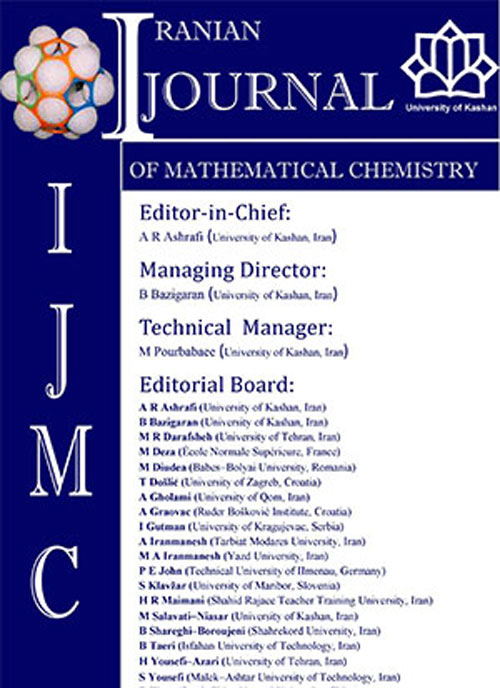فهرست مطالب

Iranian Journal of Mathematical Chemistry
Volume:6 Issue: 1, Winter - Spring 2015
- تاریخ انتشار: 1394/02/13
- تعداد عناوین: 7
-
-
Pages 1-13In this paper, we present some inequalities for the Co-PI index involving the some topological indices, the number of vertices and edges, and the maximum degree. After that, we give a result for trees. In addition, we give some inequalities for the largest eigenvalue of the Co-PI matrix of G.Keywords: Co, PI index, Co, PI matrix, Co, PI spectral radius
-
Pages 15-28Topological indices are the numerical value associated with chemical constitution purporting for correlation of chemical structure with various physical properties, chemical reactivity or biological activity. Graph theory is a delightful playground for the exploration of proof techniques in Discrete Mathematics and its results have applications in many areas of sciences. One of the useful indices for examination of structure- property relationship is Randic'' index. In this study is represented the relationship between the Randic'', Balaban and Szeged indices and Harary numbers to the enthalpies of combustion (liquid), enthalpies of vaporization(gas), enthalpies of formation (liquid) and enthalpies of sublimation () of monocarboxylic acids (C2- C20) are established, and then, some useful topological indices for examination of the structure- property relationship are presented.Keywords: Topological indices, Graph theory, Monocarboxylic acid, QSPR
-
Pages 29-39Let G be a connected simple (molecular) graph. The distance d(u, v) between two vertices u and v of G is equal to the length of a shortest path that connects u and v. In this paper we compute some distance based topological indices of H-Phenylenic nanotorus. At first we obtain an exact formula for the Wiener index. As application we calculate the Schultz index and modified Schultz index of this graph by using the Wiener index. Finally we compute eccentric connectivity index of this graph.Keywords: Wiener index, Schultz index, Modified Schultz index, Eccentric connectivity index, H, Phenylenic Nanotorus
-
Pages 41-49The harmonic index H(G), of a graph G is defined as the sum of weights 2/(deg(u)+deg(v)) of all edges in E(G), where deg (u) denotes the degree of a vertex u in V(G). In this paper we define the harmonic polynomial of G. We present explicit formula for the values of harmonic polynomial for several families of specific graphs and we find the lower and upper bound for harmonic index in Caterpillars withf diameter 4.Keywords: harmonic index, harmonic polynomial, Randić index
-
Pages 51-61An acyclic edge coloring of a graph is a proper edge coloring such that there are no bichromatic cycles. The acyclic chromatic index of a graph $G$ denoted by $chi_a ''(G)$ is the minimum number $k$ such that there is an acyclic edge coloring using $k$ colors. The maximum degree in $G$ denoted by $Delta(G)$, is the lower bound for $chi_a ''(G)$. $P$-cuts introduced in this paper acts as a powerful tool to prove that this bound is sharp for certain chemical structures.Keywords: acyclic edge, coloring, acyclic chromatic index, maximum degree, certain chemical structures
-
Pages 63-79The purpose of the matching interdiction problem in a weighted graph is to find two vertices such that the weight of the maximum matching in the graph without these vertices is minimized. An approximate solution for this problem has been presented. In this paper, we consider dendrimers as graphs such that the weights of edges are the bond lengths. We obtain the maximum matching in some types of dendrimers. Then, it is shown that proportion of difference of two optimal and approximate answers from the weight of maximum matching in these dendrimers is equal to the maximum value.Keywords: Matching, interdiction, dendrimer
-
Pages 81-92In this paper, we discuss the dynamical properties of a chemical reactor model including Lyapunov exponents, bifurcation, stability of equilibrium and chaotic attractors as well as necessary conditions for this system to generate chaos. We study the synchronization of chemical reactors model via sliding mode control scheme. The stability of proposed method is proved by Barbalate’s lemma. Numerical Simulation is provided for illustration and verification of the proposed method.Keywords: Chemical reactor, chaos, synchronization, sliding mode

